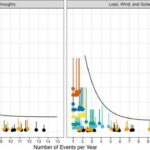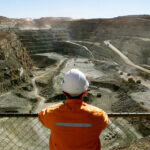Energy News Beat
Solar and wind power may be free, renewable fuels, but they also depend on natural processes that humans cannot control. It’s one thing to acknowledge the risks that come with renewable energy: the sun doesn’t always shine and the wind doesn’t always blow, but what happens when the grid loses both of these energy sources at the same time?
This phenomenon is known as a compound energy drought. In a new paper, researchers at Pacific Northwest National Laboratory (PNNL) found that in some parts of the country, these energy droughts can last nearly a week.
“When we have a completely decarbonized grid and depend heavily on solar and wind, energy droughts could have huge amounts of impact on the grid,” said Cameron Bracken, an Earth scientist at PNNL and lead author on the paper.
Grid operators need to know when energy droughts will occur so they can prepare to pull energy from different sources. On top of that, understanding where, when, and for how long energy droughts occur will help experts manage grid-level battery systems that can store enough electricity to deploy during times when energy is needed most.
The team published the findings on October 31 in the journal Renewable Energy and will be presenting at this week’s annual meeting of the American Geophysical Union.
Hunting for cloudy, windless days
In the past, researchers studied compound energy droughts on a state or regional scale. However not much has been studied on a nationwide scale. To find out more about the risk of energy droughts over the entire continental U.S., the researchers dug into weather data and then used historical energy demand data to understand how often an energy drought occurs when that energy is needed the most.
The team examined four decades of hourly weather data for the continental U.S. and homed in on geographical areas where actual solar and wind energy plants operate today. Weather data included wind speeds at the height of wind turbines as well as the intensity of solar energy falling on solar panels. Times when the weather data showed stagnant air and cloudy skies translated into lower energy generation from the wind and solar plants—a compound energy drought.
“We essentially took a snapshot of the infrastructure as of 2020 and ran it through the 40 years of weather data, starting in 1980,” Bracken said. “We are basically saying, ‘Here is how the current infrastructure would have performed under historical weather conditions.’”
The researchers found that energy droughts can occur in any season across the continental U.S., though they vary widely in frequency and duration. In California, for instance, cloudy and windless conditions might last several days, whereas the same conditions might last for only a few hours in Texas. Utah, Colorado, and Kansas experience frequent energy droughts both over several-hour timescales as well as several-day timescales.
The Pacific Northwest and Northeast, meanwhile, seem to experience energy droughts that last several hours more frequently than several days. The different timescales (hourly versus daily) will help inform the energy drought’s impact on the grid—will it last just a few hours or several days?
Overall, researchers found that the longest potential compound energy drought on an hourly timescale was 37 hours (in Texas), while the longest energy drought on a daily timescale was six days (in California).
Energy drought at peak demand
Simply knowing the where and how of energy droughts is just one piece of the puzzle, Bracken said. He also stressed that a drought of solar and wind power won’t necessarily cause an energy shortage. Grid operators can turn to other sources of energy like hydropower, fossil fuels, or energy transmitted from other regions in the U.S.
But as the nation aims to move away from fossil fuels and rely more on solar and wind power, grid operators must understand whether energy droughts will occur during times when the demand for electricity might exceed supply. Climate change brings hotter summers and more intense winter storms, and these are times when not only do people use more energy to stay safe (for cooling or heating), but access to electricity might mean life or death.
To understand the possible connection between energy droughts and energy demand, the team mapped their historical, hypothetical generation data onto 40 years of historical energy demand data that also covered real power plants across the continent.
The data showed that “wind and solar droughts happen during peak demand events more than you would expect due to chance,” Bracken said, meaning that more often than not, windless and cloudless periods occurred during times when demand for power was high. For now, Bracken isn’t certain that the correlation means causation.
“This could be due to well-understood meteorological phenomenon such as inversions suppressing wind and increasing temperatures, but further study is needed,” Bracken said.
Energy storage for energy droughts
Studying patterns in the frequency and duration of energy droughts will also help inform the deployment of long-duration energy storage projects, said Nathalie Voisin, an Earth scientist at PNNL and co-author of the paper. The paper is the first to provide a uniform standard of what a compound energy drought is and how long it can last in different parts of the country.
“We’re providing insight on how to adequately design and manage multi-day storage. So when you know an energy drought is going to last for five hours or five days, you can incentivize storage to be managed accordingly,” Voisin said.
Next, Bracken and the team will extrapolate weather and demand data into the future to see how climate change will affect the frequency and duration of energy droughts. The team plans to model energy droughts all the way to the end of the century combined with evolving infrastructure.
ENB Top News
ENB
Energy Dashboard
ENB Podcast
ENB Substack
The post ‘Energy droughts’ in wind and solar can last nearly a week, research shows appeared first on Energy News Beat.








